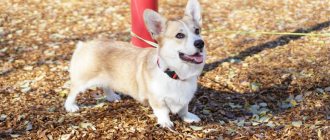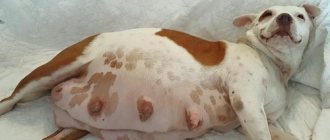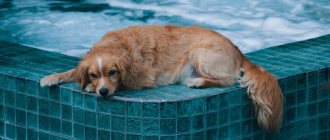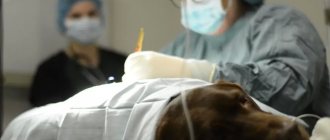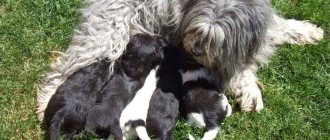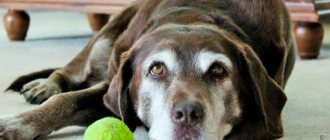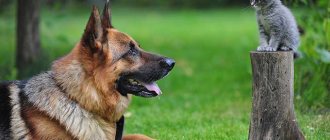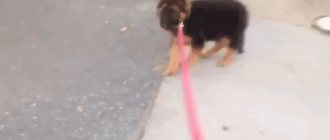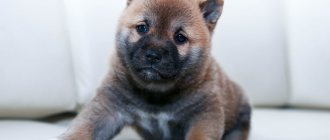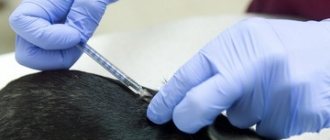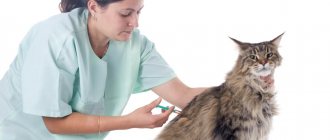A growing puppy requires routine and attention. A schedule of feeding, walks and rest allows you to raise a disciplined pet. It is important to know when to feed your dog before or after a walk and how to do it correctly. To answer this question, you need to know the physiology of your pet and how its body works.
Dogs love to run and walk - this is inherent in their nature as a hunter.
How does digestion work in dogs?
A feature of the dog’s digestive system as a carnivore is its ability to process meat, bones and the cartilaginous part connecting them.
The digestive process of a dog looks like this:
- Food crushed by teeth (as well as whole pieces) enters the esophagus into the stomach;
- Thanks to the special enzymes contained in the stomach, proteins are digested in it;
- Contraction of the walls of the stomach helps the food that enters it to mix, turning into a mushy mass (chyme), and move further to the small intestine;
- In the duodenum, through enzymes secreted by the intestines (catalysts) and the pancreas (insulin, enters the blood and regulates sugar in it), the digestion of food is completed;
- At the same time, the liver produces bile, which flows from the gallbladder into the intestines. Bile is what gives dog poop its characteristic color;
- During the above processes, nutrients from food are absorbed into the animal's body;
- Water is absorbed in the large intestine, and undigested food and inorganic elements accumulate in the rectum, from where they are excreted as feces through bowel movements.
It is noteworthy that the canine digestive process stimulates the copious secretion of saliva, which contains a microbe-destroying substance - lysozyme. Thanks to it, the mucous membrane of the mouth inside will not become inflamed from cuts by bones.
In open nature, the dog is a predator. The hunt for prey may not be successful for a long time; when you are lucky, the dog needs to eat well so that the feeling of fullness does not leave as long as possible. The dog’s stomach is adapted to this, evidence of this is its strong stretching and contraction.
Unlike herbivores and humans, in the shorter canine intestines, plant foods do not have time to be completely digested. Despite this, vegetables and fruits are necessary for your pet. Especially in the warm season. They are also important as an additional load for the intestines, as well as for enhancing its contractions (peristalsis). In addition, the fiber that forms the basis of plant foods is partially broken down in the blind section of the intestine.
For normal absorption of food, its passage through the digestive tract must be fast enough. Three peristaltic components are responsible for this:
- Active form - realized through strong stretching of the stomach and intestines;
- The background form is inherent in the dog’s intestines even in the absence of food in it and if the dog is sleeping;
- Strengthened form - carried out during the movement of the dog due to muscle work.
Let's consider how a predator feeds in its natural environment. The dog catches the prey and eats it. Large swallowed food causes the stomach to stretch, after which active contraction of the intestines begins. While these processes are happening inside, the dog is at rest, almost motionless. Gradually, the proportion of digested food increases, while the dog's stomach contracts and a considerable part of the intestinal contents is released. After this, the dog resumes physical activity, thanks to which the remaining food is absorbed. When the digestive tract is empty, the stomach contracts as much as possible and a feeling of hunger sets in - the predator is again ready to hunt and absorb fresh prey.
Considering these features inherent in the dog’s digestive system, there is no need to feed it before a walk; it is better to do it after. It is very important to distribute the load correctly: so, after feeding the dog, give it time to rest and digest the food. Then complete rest should be replaced by a light walk in a calm mode, after which, when the pet’s stomach is empty, the time for physical activity and exercise begins.
It is important to understand that active training and play immediately after eating is harmful to the dog's health. You are lucky if your pet escapes with only regurgitation of food; in dire cases, gastric volvulus occurs and more serious consequences occur. At the same time, do not forget about exercise, without which food is less digestible and digestive upset is possible.
Natural nutrition
For 1 kg of dog weight you need 15-25 g of meat. Thus, an adult dog weighing 15 kg should receive 225-375 g of meat per day. The nutritional value of fish and meat is approximately the same; if meat is replaced by offal, then they should be given approximately one and a half times more.
An acceptable diet in percentage terms is as follows:
- 30-50% meat, offal or fish;
- 25-35% cereal;
- 20-30% fermented milk products;
- 10-15% vegetables and fruits.
However, ideally, the diet should contain more meat and dairy products:
- 50-70% meat, offal or fish;
- 30-40% fermented milk products;
- 10-20% vegetables and fruits;
- 10-15% coarse.
A little sunflower oil (1-2 drops per kilogram of weight) and fish oil are added to food daily, and raw or boiled eggs are fed 2-3 times a week. Vitamin and mineral supplements are given during the period of active growth and subsequently in the off-season. Puppies of large and giant breeds are also required to be fed chondroitin, glucosamine, calcium and fat-soluble vitamins for the normal development of the musculoskeletal system. During seasonal molting, complexes for skin and coat are recommended.
Natural nutrition - confidence in the quality of products
What foods should a dog's diet consist of?
Meat (beef, poultry, rabbit) should contain some amount of cartilage, tendons, and fat. Lamb is too fatty for many dogs and causes digestive upset. Pork is not recommended to be fed raw due to its fat content and the likelihood of parasites, which are destroyed during heat treatment. Meat is supplemented or replaced with offal (heart, kidneys, udder, beef tripe) 2-3 times a week. It’s good if the dog has been accustomed since childhood to eating protein products raw, previously frozen; they can also be doused with boiling water or lightly boiled. The meat is mixed with vegetables and cereals.
It is better to feed fish raw. When feeding only raw fish, hypovitaminosis B1 develops, but for a homemade mixed diet this problem is not relevant. Fish is given instead of meat 2-3 times a week. Fillet of sea or ocean fish is suitable; river fillet must be frozen or boiled, which will avoid infection with helminths.
Dairy products in the form of cottage cheese, yogurt, kefir, sour cream 10-15% fat. Most dogs cannot digest whole milk. You can add a little honey to dairy products and beat in an egg. From time to time it is useful to cook calcined cottage cheese for your dog. It is not necessary to give milk every day. However, on those days when it is absent, it is necessary to increase the amount of meat and offal. Dairy and meat products are not mixed in one feeding.
The grains are cooked in bone broth. Rice and buckwheat are best; sometimes you can give barley and oatmeal. You should not cook corn, pearl barley, or legume porridge, which are difficult to digest.
It is better to feed vegetables raw; suitable: carrots, cucumbers, white cabbage, peppers, zucchini, pumpkin, beets. If the vegetables are not easily eaten, you can lightly stew them. Be sure to add greens, and in summer also herbs (nettle, dandelion, knotweed).
What foods should not be in a dog's diet?
Every owner should know what not to feed their dog:
- Exclusively meat and protein products - puts a lot of strain on the kidneys;
- Bones have no nutritional value and can lead to constipation and damage the gastrointestinal tract;
- Poor quality products can cause poisoning of varying severity;
- Sweets cause allergic reactions, burden the liver, provoke obesity and the development of diabetes;
- Fatty, fried foods burden the liver and pancreas;
- Salty food provokes salt deposits, joint problems, and electrolyte imbalance;
- Spicy food irritates the gastric mucosa, which can lead to gastritis and ulcers;
- Raw river fish and pork can be infected with helminths;
- Cat food high in protein and fat can lead to kidney failure;
- Legumes, products made from wheat flour and heavy cereals increase gas formation in the intestines, and in large breeds they can cause gastric volvulus.
Pros and cons of natural nutrition
Pros:
- Confidence that the dog is receiving quality products.
- Ability to independently adjust your diet.
Minuses:
- As a rule, it is more expensive than dry food and requires regular administration of vitamins and minerals
- The need to cook regularly and take up space in the refrigerator.
What happens to a dog’s body during a walk?
Walking is important for both your dog's physical and emotional health, so it's important to take your pet for walks regularly. Let's look at the most important processes that occur in a dog's body during walks.
From the point of view of the pet’s physical health, the following can be noted:
- saturation of blood with oxygen when appearing in fresh air;
- development and training of the muscular system and the whole body during running and games;
- stimulation of the gastrointestinal tract through the use of muscles;
- strengthening the nervous system through muscle activity;
- improving joint function and preventing joint diseases through physical exercise;
- avoiding obesity and constipation by running and jumping in the fresh air;
- bowel and bladder emptying.
The benefits of walking for digestion begin after food from the stomach enters the intestines and beneficial elements begin to be actively absorbed into the blood. This happens 3 or 4 hours after eating, at which time (until complete digestion) you can go for a walk with the dog. Be sure to start with leisurely exercise and later move on to active games and training.
Walking is also an integral part of the psycho-emotional state of a four-legged pet. During them, the dog interacts with the outside world, learns to perceive strangers, other animals, birds, objects and smells. Socialization is an important aspect of a pet's development and health.
Food digestion process
During feeding, the dog’s body receives all the elements necessary for further life, this happens in several stages. At the first stage, it needs to digest food, break it down into enzymes, and then absorb it in the body.
When the dog has eaten, mechanical processing of food in the mouth cavity begins (this is the second stage). In the third stage, food enters the stomach and is digested. Once the food bolus gets into it, it mixes with gastric juice containing hydrochloric acid and enzymes that break down proteins, fats and other substances into forms that are easily digestible by the body. The food gruel processed in the stomach enters the small intestine and is absorbed by the body.
When is it better to walk your dog: before or after meals?
Taking into account the peculiarities of the dog’s digestive system, we can conclude that it is better to take walks before starting to feed the animal. Several points speak in favor of this:
- On walks, the dog likes to be active - run, jump, play, but this cannot be done immediately after eating. Major problems with the stomach are possible, including volvulus and severe pain.
- When active on a full stomach, the load on the pet’s cardiovascular system increases, since in a well-fed state, habitual manipulations are harder and require more energy to implement.
- A walk, which usually brings joy and satisfaction to the pet, will become painful for the dog itself if it is done after a meal. The dog will be more tired than usual and will feel heaviness rather than pleasure from walking.
- A walk on an empty stomach will allow the dog to release as much pent-up energy as possible, run and jump to its heart's content and, of course, work up an appetite. Having realized all its walking potential, the dog will quickly rush home, getting pretty hungry. This way both the owner and the pet will be satisfied.
Accordingly, there is no need to feed the dog before a walk. An exception may be individuals suffering from diseases such as diabetes or hypoglycemia.
Interesting things to do while walking
Let's see what interesting things you can do while walking:
- Teaching basic commands is an essential aspect of parenting.
- Walking to unfamiliar places is a great socialization technique.
- Learning to find objects.
- Learning tricks.
- Various sports exercises - playing with Frisbee, overcoming obstacles, elements of agility.
This list is far from complete, especially if there is a dog training area near your home. You can teach your pet absolutely any skills and sports. It is much more fun to train in the company of trained dogs, in which case your pet will learn by imitating its relatives, and this is much faster and more interesting
When should you walk your puppy?
Walking with an adult dog should be done before feeding, which is usually twice a day (morning and evening), as well as during the day, 4-6 hours after breakfast. During walks, the pet goes to the toilet - normal bowel movements also occur twice a day.
With young dogs the situation is a little different: depending on the age of the baby, the number of feedings can vary from two to six. Let's try to figure out when to walk the puppy - before or after eating.
A new owner should know that from childhood a dog is taught to go to the toilet in the fresh air during walks. Gradually, the puppy should get used to having bowel movements twice a day - in the morning and in the evening. However, unlike an adult, the baby at first cannot restrain the desire to defecate, and you cannot force him to endure it for a long time - otherwise the colon may become inflamed and cystitis may develop. Therefore, it is worth observing the puppy’s behavior and walking him both before and after meals when he needs it.
Very young puppies who have just begun to go outside, after eating, quickly feel the urge to go to the toilet. This is facilitated by frequent meals in small portions (4-6 times a day). Since the time between feedings can be 4 hours or even less, it is not possible to walk your puppy several hours after eating (as with an adult dog).
To summarize: walks can be arranged before or after it is time to feed the puppy. After eating, he will be able to go to the toilet outside the house without having to endure it for a long time and without harming his health. The main thing is to follow a few simple rules: choose a quieter place for a walk and do not run or play active games on a full stomach. However, on an empty stomach, in addition to going to the toilet, the baby will be able to thoroughly enjoy time in the fresh air, run, jump and adapt to the world around him. Therefore, it is worth gradually accustoming your baby to an adult schedule: morning and evening walks with a trip to the toilet.
Subscribe to the newsletter and receive a discount from the Pet store
Thanks for subscribing!
An email with a promotional code has already been sent to your email.
Norms and dosages
When feeding your pet with ready-made branded food, dry or canned, you need to check the table of recommended norms provided by the manufacturer. The serving size corresponding to the dog's weight and activity level is always indicated on the package.
If the owner prefers natural feeding, it is useful to build on the following indicators:
| Product groups | Types of products | % of total diet |
| Meat, seafood, eggs | beef, rabbit, turkey, chicken (in small quantities), offal, sea fish (completely boned), chicken eggs (boiled) | 40 – 70 % |
| Dairy products | cottage cheese, low-fat kefir, fermented baked milk, yogurt, hard cheese | 20 – 40 % |
| Cereals | buckwheat, rice, oatmeal | 20 – 40 % |
| Vegetables fruits | pumpkin, carrots, zucchini, bell peppers, apples, white cabbage (in small quantities), greens | 10 – 20 % |
It is important to understand that different products should be alternated, sometimes adding and changing certain components. For example, fish is given 1 - 2 times every 7 - 10 days, offal is added approximately 1 - 2 times a week
Chicken eggs can be given 2 - 4 times a week, 1 - 2 pcs. for medium and large dogs and 0.25 - 1 pc. for small ones. The main component is meat and cereals.
Meat, offal, and fish are given exclusively in boiled form, since such products without proper heat treatment can become a source of infection with helminths (parasitic worms) or microbial diseases. Freezing or dousing with boiling water is not effective enough to make such food safe. Contrary to misconceptions, boiled meat and fish do not lose their nutritional benefits and are perfectly digestible.
Chicken is a very suitable food
Chicken meat is given with caution, as it causes allergic reactions in many dogs - rashes, dandruff, alopecia (local hair loss), and sometimes itching may occur. In addition, recent studies have shown that chicken is quite a difficult product to digest.
The fish must be exclusively sea or oceanic. Freshwater species are not suitable for the content of various substances in them, and they are also too bony, which creates an additional risk of injury to the pet’s mouth, esophagus and even stomach.
Milk should not be given. In puppies, it often causes indigestion, coagulates in the stomach and leads to diarrhea and vomiting. In adult dogs, even those that accepted dairy products well, over time they stop producing lactase (an enzyme that breaks down lactose - milk sugar), which is also fraught with digestive disorders.
When composing the diet, it is worth considering that representatives of small, medium and large breeds have different daily energy requirements:
| Dog sizes | Daily energy requirement |
| Mini breeds (up to 5 kg) | 110 kcal/1 kg body weight |
| Small (5 – 10 kg) | 85 kcal/1 kg body weight |
| Medium (10 – 20 kg) | 70 kcal/1 kg body weight |
| Large (20 – 40 kg) | 60 kcal/1 kg body weight |
| Giant breeds (40 – 80 kg) | 55 – 50 kcal/1 kg body weight |
In addition to the main products, the dog’s diet should contain vitamins, micro- and macroelements from an additional source (ready-made complex supplements). Daily intake of vitamins for dogs:
| Vitamin name | For growing dogs | For adult dogs |
| A (carotenoid) | 200 IU | 100 IU |
| B1 (thiamine) | 36 mcg | 18 mcg |
| B2 (riboflavin) | 0.08 mg | 0.04 mg |
| B3 (pantothenic acid) | 200 mcg | 50 mcg |
| B6 (pyridoxine) | 44 mcg | 22 mcg |
| B12 (cyanocobalamin) | 1 mcg | 0.7 mcg |
| Bc (folic acid) | 8.8 mcg | 4.4 mcg |
| D (cholecalciferol) | 20 IU | 10 IU |
| E | 2.2 mg | 2.2 mg |
| PP (nicotinic acid) | 400 mcg | 200 mcg |
| Kholin | 55 mg | 28 mg |
Basic rules for walking dogs
For a four-legged pet, walks and outdoor activities are a must. Let's look at the basic rules that dog owners should follow.
Formation of the regime
One of the important components of a pet’s healthy lifestyle is a routine. This applies to eating, walking, and going to the toilet. In order for the ward to be in excellent physical shape and to be in an excellent mood, the owner needs to accustom him to a daily routine from the first days.
Most often, breeders choose morning and evening hours for walking and feeding - upon waking up and before leaving for work or training, as well as upon returning home. The duration of walks and their number increases on weekends, when the owner is physically able to devote more time to his ward.
Unlike an adult, a baby requires more frequent walks in connection with learning to go to the toilet outside. It is enough to give them 15-20 minutes. Over time, the young pet is transferred to the adult regime and walked twice a day. During these walks, he should empty his bowels and bladder.
Walking and feeding order
Forming a daily routine is a must in the life of a four-legged friend. According to the recommendations of veterinarians and experienced breeders, the dog’s daily routine should look like this:
- In the morning – a half-hour or an hour (if possible) walk. At this time, the pet gets rid of the remnants of dinner (digested food) - goes to the toilet “in a big way.”
- Morning feeding after a walk (with standard meals twice a day).
- A 15-20 minute walk during the day to empty your bladder.
- In the evening - exercise, as well as active games and physical activity, training. Longer stay in the fresh air with accompanying training of the pet.
- Evening feeding upon returning from the street.
Duration of stay on the street
In the morning you can take a shorter walk - 30-60 minutes is enough, and in the evening you should devote more time to it - an hour or more (the longer the better).
By adding three more short trips to the yard (for 10-15 minutes) to the two main ones (morning and evening), you will give your pet the opportunity to exercise a little in the fresh air and empty his bladder. Unlike bowel movements twice a day, normal urination of four-legged pets can be up to five times a day.
